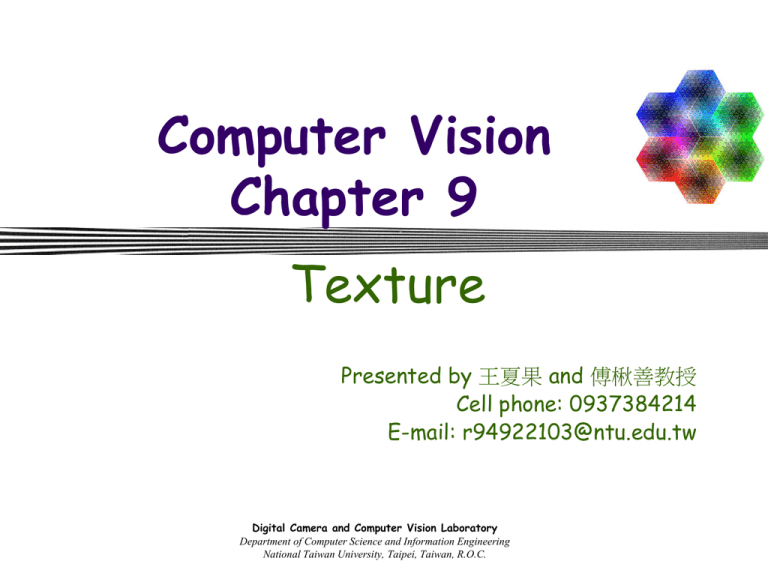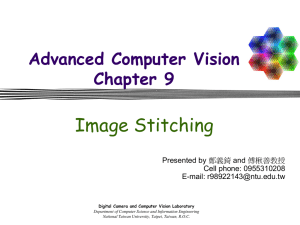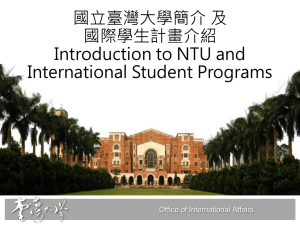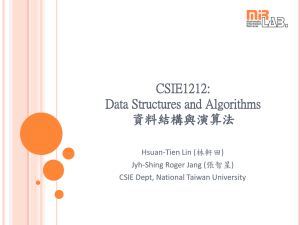Texture - Digital Camera and Computer Vision Laboratory
advertisement

Computer Vision
Chapter 9
Texture
Presented by 王夏果 and 傅楸善教授
Cell phone: 0937384214
E-mail: r94922103@ntu.edu.tw
Digital Camera and Computer Vision Laboratory
Department of Computer Science and Information Engineering
National Taiwan University, Taipei, Taiwan, R.O.C.
Introduction
What does texture mean? Formal approach
or precise definition of texture does not exist!
Texture discrimination techniques are for the
part ad hoc.
DC & CV Lab.
CSIE NTU
Definition of Texture
Non-local property, characteristic of region
larger than its size
Repeating patterns of local variations in
image intensity which are too fine to be
distinguished as separated objects at the
observed resolution
DC & CV Lab.
CSIE NTU
Definition of Texture (cont.)
For humans, texture is the abstraction of
certain statistical homogeneities from a
portion of the visual field that contains a
quantity of information grossly in excess of
the observer’s perceptual capacity
DC & CV Lab.
CSIE NTU
DC & CV Lab.
CSIE NTU
DC & CV Lab.
CSIE NTU
DC & CV Lab.
CSIE NTU
DC & CV Lab.
CSIE NTU
DC & CV Lab.
CSIE NTU
DC & CV Lab.
CSIE NTU
Texture Analysis Issues
Pattern recognition: given texture region,
determine the class the region belongs to
Generative model: given textured region,
determine a description or model for it
Texture segmentation: given image with
many textured areas, determine boundaries
DC & CV Lab.
CSIE NTU
DC & CV Lab.
CSIE NTU
Statistical Texture-Feature
Approaches
Autocorrelation function
Spectral power density function
Edgeness per unit area
Spatial gray level co-occurrence probabilities
Graylevel run-length distributions
Relative extrema distributions
Mathematical morphology
DC & CV Lab.
CSIE NTU
Image Texture Analysis
Give a generative model and the values of its
parameters, one can synthesize
homogeneous image texture samples
associated with the model and the given
value of its parameters.
DC & CV Lab.
CSIE NTU
Image Texture Analysis (cont.)
Verification: verify given image textures
sample consistent with model
Estimation: estimate values of model
parameters based on observed sample
examples of model-based techniques
DC & CV Lab.
CSIE NTU
Some Model-Based Techniques
Autoregressive, moving-average, time-series
models (extended to 2D)
Markov random fields
Mosaic models
DC & CV Lab.
CSIE NTU
Texel
Texture element, basic textural unit of some
textural primitives qualitatively evaluated
image texture properties
DC & CV Lab.
CSIE NTU
Some Texture Features
Fineness
Coarseness
Contrast
Directionality
Roughness
Regularity
Smoothness
Granulation
DC & CV Lab.
CSIE NTU
Some Texture Features (cont.)
Randomness
Lineation
Mottled
Irregular
Hummocky
DC & CV Lab.
CSIE NTU
Take a Break
DC & CV Lab.
CSIE NTU
Texture and Scale
For any textural surface, there exists a scale
at which, when the surface is examined, it
appears smooth and textureless. (see from
infinite distance)
As resolution increases, the surfaces appears
as a fine texture and then a coarse one, and
for multiple-scale textural surface the cycle of
smooth, fine, and coarse may repeat.
DC & CV Lab.
CSIE NTU
Texture and Scale (cont.)
Thus, texture cannot be analyzed without
frame of reference on scale or resolution.
Texture is a scale-dependent phenomenon.
DC & CV Lab.
CSIE NTU
DC & CV Lab.
CSIE NTU
Characterizing Texture
Characterize gray level primitive properties
Characterize spatial relationships between
them
DC & CV Lab.
CSIE NTU
First-Order Gray-Level Statistics
Statistics of single pixels
E.g. Histogram, mean, median, variance
DC & CV Lab.
CSIE NTU
Second-Order Gray-Level
Statistics
The combined statistics of gray levels of pairs
of pixels in which each two pixels in a pair
have a fixed relative position
E.g. co-occurrence
Gray level spatial dependence: characterize
texture by co-occurrence
DC & CV Lab.
CSIE NTU
Co-Occurrence Matrix
The gray level co-occurrence can be
specified in a matrix of relative frequencies Pij
with which two neighboring pixels separated
by distance d occur on the image, one with
gray level i and the other with gray level j
Symmetric matrix
Function of angle and distance between
pixels
DC & CV Lab.
CSIE NTU
2)
DC & CV Lab.
CSIE NTU
Co-Occurrence Matrix (cont.)
Probability of horizontal, d pixels apart pixels
P(i, j, d, 0°) =
#{[(k, l), (m, n)] | k-m = 0, |l-n| = d, I(k, l) = i, I(m,n) = j}
Probability of 45°, d pixels apart pixels
P(i, j, d, 45°) =
#{[(k, l), (m, n)] | (k-m = d, l-n = -d) or (k-m = -d, l-n = d),
I(k, l) = i, I(m,n) = j}
DC & CV Lab.
CSIE NTU
Co-Occurrence Matrix (cont.)
Probability of 90°, d pixels apart pixels
P(i, j, d, 90°) =
#{[(k, l), (m, n)] | |k-m| = d, l-n = 0, I(k, l) = i, I(m,n) = j}
Probability of 135°, d pixels apart pixels
P(i, j, d, 135°) =
#{[(k, l), (m, n)] | (k-m = d, l-n = d) or (k-m = -d, l-n = -d),
I(k, l) = i, I(m,n) = j}
DC & CV Lab.
CSIE NTU
0
DC & CV Lab.
CSIE NTU
Co-Occurrence Matrix (cont.)
Matrix symmetric: P(i, j, d, a) = P(j, i, d, a)
DC & CV Lab.
CSIE NTU
Take a Break
DC & CV Lab.
CSIE NTU
DC & CV Lab.
CSIE NTU
Matrix with Highest Entropy
When all entries in Pij are equal
Image where no preferred gray-level pairs
exist features calculated from the cooccurrence matrix
DC & CV Lab.
CSIE NTU
Generalized Gray Level Spatial
Dependence Models for Texture
Simple generalization: consider more than
two pixels at a time
DC & CV Lab.
CSIE NTU
Generalized Co-Occurrence
Strong texture measures take into account
the co-occurrence between texture primitives.
DC & CV Lab.
CSIE NTU
Texture Primitive
Connected set of pixels characterized by
attribute set
Simplest primitive: pixel with gray level
attribute
More complicated primitive: connected set of
pixels homogeneous in level, characterized
by size, elongation, orientation, and average
gray level
DC & CV Lab.
CSIE NTU
Spatial Relationship
We have a list of primitives, their center
coordinate, and their attributes after the
primitives have been constructed.
DC & CV Lab.
CSIE NTU
Spatial Relationship (cont.)
DC & CV Lab.
CSIE NTU
Autocorrelation Function
Texture relates to the spatial size of the gray
level primitives on an image
Gray level primitives of larger size are
indicative of coarser texture
Gray level primitives of smaller size are
indicative of finer texture
DC & CV Lab.
CSIE NTU
Autocorrelation Function (cont.)
Autocorrelation function describes the size of
gray level primitives
DC & CV Lab.
CSIE NTU
Autocorrelation Function (cont.)
DC & CV Lab.
CSIE NTU
Autocorrelation Function (cont.)
DC & CV Lab.
CSIE NTU
Autocorrelation Function (cont.)
If the gray level on image is relatively large:
texture is coarse, autocorrelation drops off
slowly with distance
If the gray level on image is relatively small:
texture is fine, autocorrelation drops off
quickly with distance
Periodic
DC & CV Lab.
CSIE NTU
Take a Break
DC & CV Lab.
CSIE NTU
Digital Transform Methods and
Texture
In the digital transform method of texture
analysis, the digital image is typically divided
into a set of non-overlapping small square
subimages
The vectors is reexpressed in a new
coordinate system
Fourier transform uses the complex sinusoid
basic set, Handamard transfer uses the
Walsh function basic set, …..
DC & CV Lab.
CSIE NTU
Texture Energy
The image is first convolved with a variety of
kernels
Then each convolved image is processed
with a nonlinear operator to determine the
total textural energy in each pixel’s
neighborhood
DC & CV Lab.
CSIE NTU
Texture Edgeness
Autocorrelation function and digital transform
both reference texture to spatial frequency
Texture Edgeness: conceive texture in terms
of edgeness per unit area
DC & CV Lab.
CSIE NTU
Texture Edgeness (cont.)
Use small neighborhood to detect microedge
Use large neighborhood to detect macroedge
DC & CV Lab.
CSIE NTU
DC & CV Lab.
CSIE NTU
Vector Dispersion
Divide the texture into mutually exclusive
neighborhoods
A sloped plane fit to the gray levels is
performed for each neighborhood
DC & CV Lab.
CSIE NTU
DC & CV Lab.
CSIE NTU
Relative Extrema Density
Count the number of extrema per unit area
for a texture measure
One dimension, along a horizontal scan
DC & CV Lab.
CSIE NTU
Relative Extrema Density (cont.)
Relative minimum:
g(i) ≦ g(i+1) and g(i) ≦ g(i-1)
Relative maximum:
g(i) ≧ g(i+1) and g(i) ≧ g(i-1)
Pixels in a constant run: both minimum and
maximum
Center a square window around each pixel,
and count the number of extrema pixels
DC & CV Lab.
CSIE NTU
Mathematical Morphology
Granularity of a binary image F:
# F Hd
G (d ) 1
#F
#F: number of elements in F
H d : disk structuring element of diameter d
G(d) measures the proportion of pixel
participating in grains of size smaller than d
DC & CV Lab.
CSIE NTU
Mathematical Morphology (cont.)
Scale-k volume of the blanket around a gray
level intensity surface I:
V (k ) ( I k H )(r, c) ( Ik H )(r, c)
( r ,c )
⊕k: k-fold dilation
Θk: k-fold erosion
DC & CV Lab.
CSIE NTU
Autoregression Models
Doing linear estimates of a pixel’s gray level
with the gray levels in the neighborhood
For coarse texture, coefficient will be similar
For fine texture, coefficient will vary widely
DC & CV Lab.
CSIE NTU
Autoregression Models
Next gray value aN+1 : linear combination of
synthesized data and noise value
ak : given starting sequence
bk : randomly generated noise image
DC & CV Lab.
CSIE NTU
DC & CV Lab.
CSIE NTU
Autoregression Models (cont.)
Two-dimensional autoregression model:
DC & CV Lab.
CSIE NTU
DC & CV Lab.
CSIE NTU
Autoregression Models (cont.)
Easy to use the estimator in a node that
synthesized textures from any initially given
linear estimator
Sufficient to capture everything in a texture
But the textures it can characterize are likely
to consist mostly of microtextures
Microtexture: gray level primitives are small,
spatial interaction between primitives is local
DC & CV Lab.
CSIE NTU
Take a Break
DC & CV Lab.
CSIE NTU
Discrete Markov Random Fields
Assumption: the texture field is stochastic
and stationary and satisfies a conditional
independence assumption
When the distributions are Gaussian, each
pixel’s value is a combination of the value in
its neighborhood plus a noise term
DC & CV Lab.
CSIE NTU
Discrete Markov Random Fields
(cont.)
h: coefficients, computed from texture image with
least-square method
u: joint set of possible correlated Gaussian
random variables
DC & CV Lab.
CSIE NTU
Random Mosaic Models
Constructing steps:
1. Provide a mean of tessellating a plane into
cells
2. Assign a property value to each cell
DC & CV Lab.
CSIE NTU
Structural Approaches to Texture
Models
Pure structural model: primitives in regular
repetitive spatial arrangements
To describe the texture, describe the
primitives and the placement rules
DC & CV Lab.
CSIE NTU
Texture Segmentation
Each region has homogeneous texture, and
each pair of adjacent regions is differently
textured
DC & CV Lab.
CSIE NTU
Synthetic Texture Image
Generation
Fractals: shapes that exhibit recursive selfsimilarity
Every fractal can be recursively subdivided
into smaller non-overlapping shapes, each of
which is a scale-down version of the whole,
either in a deterministic sense or in a
statistical sense
DC & CV Lab.
CSIE NTU
Shape from Texture
Use image texture gradients to estimate
surface orientation of the observed 3D object
Assumption: no depth changes and no
texture changes in observed texture area,
and no subtextures
DC & CV Lab.
CSIE NTU
DC & CV Lab.
CSIE NTU
DC & CV Lab.
CSIE NTU
DC & CV Lab.
CSIE NTU
Shape from Texture (cont.)
Unknown plane where texture observed
Ax + By + Cz + D = 0
where A2 B 2 C 2 1
From perspective projection, 3D point
(x, y, z) with projection (u, v)
x
u f
z
y
v f
z
DC & CV Lab.
CSIE NTU
Shape from Texture (cont.)
Df
z
Au Bv Cf
•Solving z, …., use similar triangle geometry
DC & CV Lab.
CSIE NTU
DC & CV Lab.
CSIE NTU
DC & CV Lab.
CSIE NTU
Summary
Texture: in terms of primitives and spatial
relationships
Qualitatively, shape from texture can work
Quantitatively, the techniques are generally
not dependable
DC & CV Lab.
CSIE NTU






